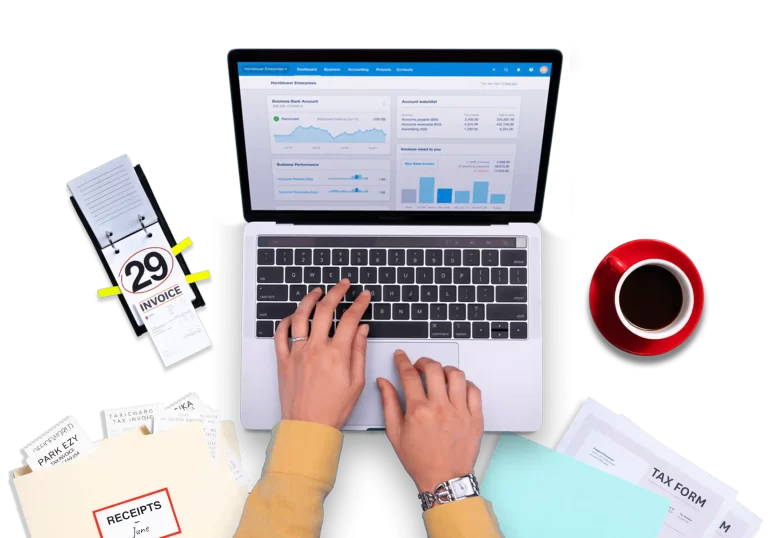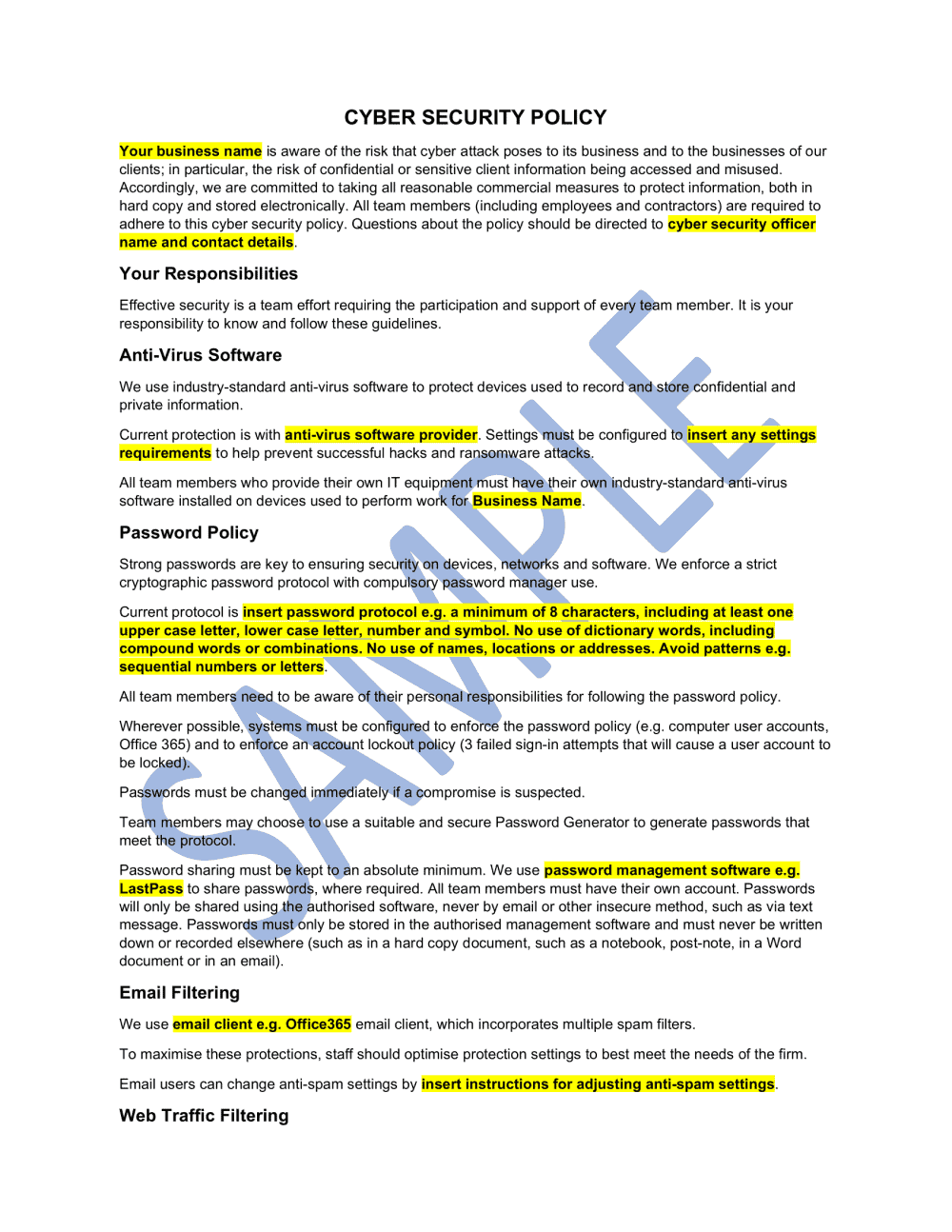Cyber Security Policy
$149.00 inc. GST
- User friendly Word template
- Written in plain English by Australian lawyers
- Peace of mind that your business is secure
- Protect your business in minutes, not months
- Instant download with expert customer support
- Instant Download
- 90-Day Money Back Guarantee
- Lifetime Access
- Word Document Format
How it Works
Fast and simple legal protection. You'll wonder why you didn't do it sooner.
Get your Template
Go to your Inbox
Peace of mind
We make legal documents for real people
You’re running a business, not a law firm. You want the peace of mind of knowing your business is protected, without spending months, or your life savings doing it. Our lawyers know their stuff. We make affordable, rock-solid legal documents and don’t cut corners.

Sleep well. Act sharp. You’re covered.
You’re three clicks away from the peace of mind that comes with knowing your business is protected. No more second-guessing. No more doubts. Run your business with clarity because you have the contract you need when you need it. Feel confident and in control.

Win clients with wow worthy contracts
Make an un-ignorable first impression. Stand out in the crowd. Win business with legal documents that show you mean business. We’ve got the legals covered. Add your branding pzazz and wow your clients. Grow your business – securely.

What is Cyber Security?
Cyber Security is the practice of protecting systems, networks, and programs from digital attacks.
These cyberattacks usually aim to access, change, or destroy sensitive information, extort money from users, or interrupt normal business processes.
Common methods you might have heard of include viruses, trojan horses, malware, phishing emails and credit card fraud.
There are three key pillars of Cyber Security:
- People – every employee needs to play their part
- Processes – clearly defined rules and procedures to protect the business
- Technology – things like anti-virus and password protection
What is a Cyber Security Policy?
A Cyber Security Policy sets out guidelines to protect the security of technology and information assets in your business.
Our Cyber Security Policy template includes rules and processes your employees should follow.
Some of the issues the policy covers are:
- the type of business information that can be shared and where
- acceptable use of devices and online materials
- handling and storage of sensitive material
- rules and controls for protecting your business
Who is this Cyber Security Policy for?
- All types of business
- Any business which uses the internet – for email, banking, running a website or other activities
- You want to protect your business from online attacks and breaches
- You want to inform employees or contractors about how to handle sensitive information and infrastructure
- You want to improve security in your business
Do I need a Cyber Security Policy?
Yes, it’s important to create a cyber security policy for your business – particularly if you have employees.
Cyber crime is on the rise in Australia, and small businesses are not immune!
According to a 2016 report by cybersecurity firm Symantec, 43% of cyber-attacks are targeted against small businesses.
Businesses that don’t have a cyber security policy could be leaving themselves open to attacks and legal issues.
What does our Cyber Security Policy template cover?
Our Cyber Security Policy template covers:
- Your responsibilities – responsibility of each team member to follow the guidelines
- Anti-Virus Software – use and installation of anti-virus
- Password policy – password protocol, changing passwords, sharing passwords etc
- Email filtering and web traffic filtering – description of any email filtering or web traffic filtering
- Bank account and payment details – recommend confirming bank details with suppliers by phone before payment
- Two-factor authentication – any programs that need two-factor authentication
- Removable Hardware – rules around using removable hardware (e.g. USB drives) for storing and sharing information
- Office Wireless Network and Public WiFi – access to networks and rules around using public/private WiFi
- Backup – protocols for backing up company information
- Disaster Recovery Plan – details of key resources, software and contact details, recovery procedures and arrangements
- Data Breach Plan – a checklist of things to do in the event of a data breach
- Training and awareness– onboarding and cyber security training for team members
- Cyber Insurance – details of any cyber insurance cover taken out by the business
- Cyber Risk Assessment – annual review and risk assessment by the cyber security officer
How do I use a Cyber Security Policy?
We recommend that you complete the following:
- Complete our Cyber Security Policy template for your business, including all of the rules you want to set
- Conduct a regular audit of cyber security in your business
- Provide the Cyber Security Policy to all employees and require them to sign off on it
- Complete regular training and send reminders to all staff about their obligations
- Check your insurance policy to make sure it covers cyber crime.
The Australian government has a website called Stay Smart Online, which has some great cyber security tips.
How often should we update our Cyber Security Policy?
We recommend that you complete an audit annually to update your cyber security policy and procedures.
What are the different types of cyber security threats?
There are several different types of cyber security threats:
- Phishing – sending fraudulent emails that resemble emails from reputable sources. This is the most common type of cyber attack. The goal is usually to steal sensitive information like credit cards and login information.
- Ransomware – malicious software which is designed to extort money by blocking access to files or the computer network until the ransom is paid
- Malware – a type of software designed to gain unauthorized access or to cause damage to a computer.
- Social Engineering – a tactic where hackers trick you into revealing sensitive information. They can solicit a monetary payment or gain access to your confidential data. Social engineering can be combined with any of the threats listed above to make you more likely to click on links, download malware, or trust a malicious source.
Why Customers Love our Cyber Security Policy
Read reviews from other happy business owners...
Take the stress out of legal documents
Get peace of mind with our Cyber Security Policy today!
Frequently Asked Questions
Got Questions? We've Got the Answers!
All of our templates come in Word format (docx).
We recommend using Microsoft Word on a desktop to fill in the templates.
Our templates are Word documents so they’re editable.
We don’t recommend editing the template outside the highlighted areas. An experienced lawyer wrote your template. If you delete or modify clauses it could affect your protection.
We know you’re a smart cookie, but we highly recommend avoiding the temptation to fiddle.
Yes, you get lifetime access to your template.
You’ve got a contract ready to go whenever you need it in your business.
Definitely!
Change your font, add your logo and even some colour. Present your document in your brand style and delight your clients. You’ll still be legit. You’ll just look amazing-er.
All of our templates come with instructions on the first page.
We also include comments throughout the document to help guide you as you fill out each section.
Yes. All our templates are written by qualified Australian lawyers who hold an Australian legal practicing certificate.
Our co-founder Courtney Bowie is a partner in Sydney law firm, Her Lawyer.
Yes. You can use the templates in all Australian states and territories.
If a law changes, we’ll update your template and send it to you – for free.
No hidden catches here. When you buy a template or bundle you own them for life. The download links never expire.
No recurring fees. No accounts. Just buy what you need. Simple, right?
If you have a question, contact us. We’re always happy to help.
Email: info@easylegaltemplates.com.au
Phone: 1300 490 145
You may also like...
90-Day Money Back Guarantee
We’re so confident you’ll love our products, we offer a no-hassle refund within 90 days of purchase. If you’re not happy for any reason, we’ll work with you to make sure you're happy, even if that means a full refund.





